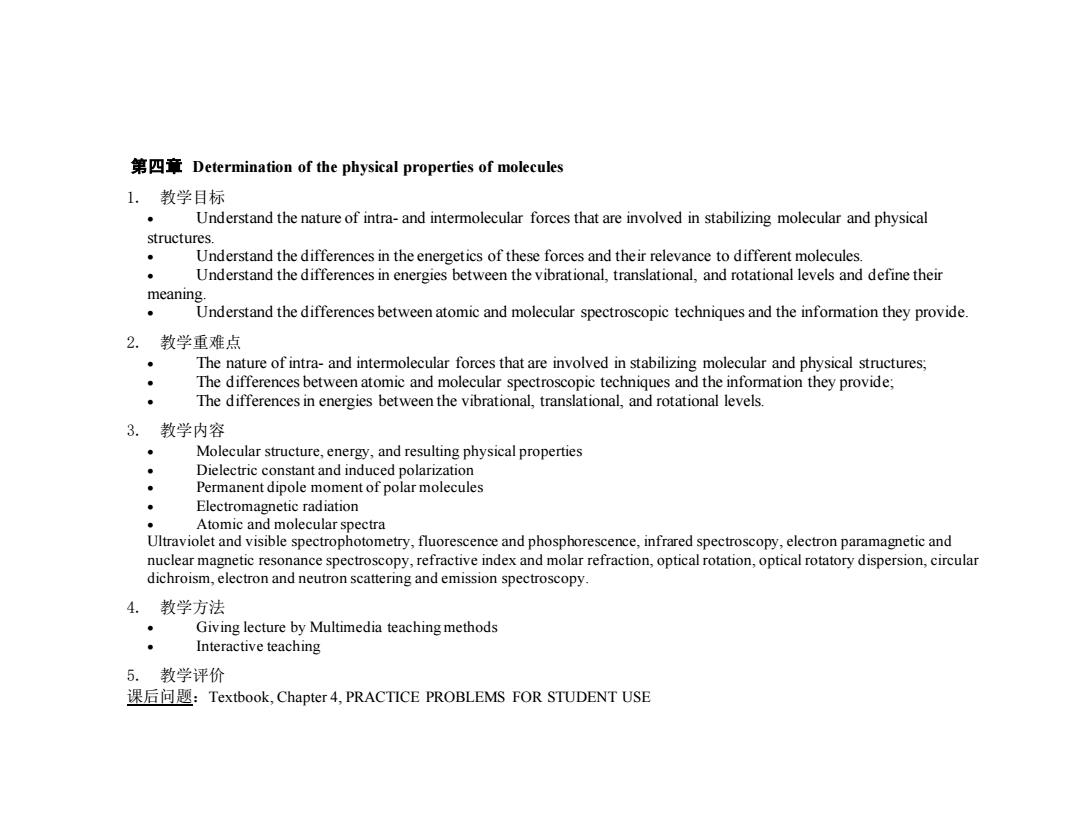正在加载图片...

第四章Determination of the physical properties of molecules 1.教学目标 Understand the nature of intra-and intermolecular forces that are involved in stabilizing molecular and physical structures. Understand the differences in the energetics of these forces and their relevance to different molecules. Understand the differences in energies between the vibrational,translational,and rotational levels and define their meaning. Understand the differences between atomic and molecular spectroscopic techniques and the information they provide. 2.教学重难点 The nature of intra-and intermolecular forces that are involved in stabilizing molecular and physical structures; The differences between atomic and molecular spectroscopic techniques and the information they provide; The differences in energies between the vibrational,translational,and rotational levels. 3.教学内容 Molecular structure,energy,and resulting physical properties Dielectric constant and induced polarization Permanent dipole moment of polar molecules Electromagnetic radiation Atomic and molecular spectra Ultraviolet and visible spectrophotometry,fluorescence and phosphorescence,infrared spectroscopy,electron paramagnetic and nuclear magnetic resonance spectroscopy,refractive index and molar refraction,optical rotation,optical rotatory dispersion,circular dichroism,electron and neutron scattering and emission spectroscopy 4.教学方法 Giving lecture by Multimedia teaching methods Interactive teaching 5.教学评价 课后问题:Textbook,Chapter4,PRACTICE PROBLEMS FOR STUDENT USE第四章 Determination of the physical properties of molecules 1. 教学目标 • Understand the nature of intra- and intermolecular forces that are involved in stabilizing molecular and physical structures. • Understand the differences in the energetics of these forces and their relevance to different molecules. • Understand the differences in energies between the vibrational, translational, and rotational levels and define their meaning. • Understand the differences between atomic and molecular spectroscopic techniques and the information they provide. 2. 教学重难点 • The nature of intra- and intermolecular forces that are involved in stabilizing molecular and physical structures; • The differences between atomic and molecular spectroscopic techniques and the information they provide; • The differences in energies between the vibrational, translational, and rotational levels. 3. 教学内容 • Molecular structure, energy, and resulting physical properties • Dielectric constant and induced polarization • Permanent dipole moment of polar molecules • Electromagnetic radiation • Atomic and molecular spectra Ultraviolet and visible spectrophotometry, fluorescence and phosphorescence, infrared spectroscopy, electron paramagnetic and nuclear magnetic resonance spectroscopy, refractive index and molar refraction, optical rotation, optical rotatory dispersion, circular dichroism, electron and neutron scattering and emission spectroscopy. 4. 教学方法 • Giving lecture by Multimedia teaching methods • Interactive teaching 5. 教学评价 课后问题:Textbook, Chapter 4, PRACTICE PROBLEMS FOR STUDENT USE